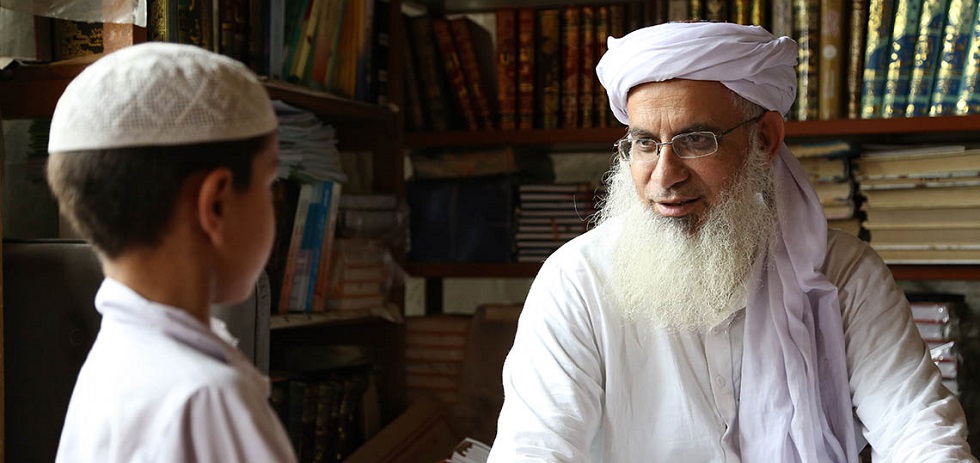The latest from filmmakers Hemal Trivedi and Muhammad Ali Naqvi, Among The Believers, is a fascinating look at the rise of religious extremism in Pakistan, as young children are indoctrinated into following a radical form of Islam by fundamentalist madrassahs (seminaries) offering free food, education, housing and medical care to the nation’s poorest (something which is not offered by the Pakistani government at this point). The film is constructed through a series of interviews we follow students, teachers, those trying to ease the spread of extremism in Pakistan, and the leader of the Red Mosques, an infamous group of teaching institutions, linked with a large number of domestic and international attacks.
In these interviews we get a feel for the current socio-political climate of Pakistan, one that is actually not too dissimilar from that of Western countries; the majority of Islamic Pakistan are only as religious as your distant aunt, only attending church on a big religious holiday like Christmas, and never actually following anything in the religious texts too closely. One of the film’s biggest strengths is in dispelling the Western notion that Pakistan is some hotspot for extremism with a backwards government and a population that wants to kill all non-believers. Instead we see a much more nuanced depiction of the country, in which a form of cultish extremism has run amok, indoctrinating young minds with promises of food, shelter, and eternal life for them and 10 of their family members if they dedicate their youth to memorizing the Qu’ran and trusting a man who wants nothing more than to bring us back into the Middle Ages.
It’s easy to see why people turn to this path when we’re shown the alternatives; life as a poor Pakistani child means impoverishment, hunger, and for some arranged marriage at a very young age. When you consider the socio-economic circumstances that have allowed these madrassahs to flourish (circumstances that are laid out and dissected perfectly in this film), it’s no wonder that parents who are finding it hard to provide for themselves, let alone their kids, turn to these extremist seminaries to provide their kids with housing and education – especially when you consider that traditional schooling institutions cost money and attendance is not subsidized by the government. Among The Believers also perfectly conveys that the close-reading of the Qu’ran followed by attendees of the Red Mosque is fundamentalist and extreme in nature, and not at all the reading that the majority of Pakistan’s overwhelmingly Muslim population follows (again, with an approach closer to that of how people follow the Christian Bible in America or Australia).
While the film proficiently explains how institutions like the Red Mosque have risen to power and spread, and perfectly gets across the notion that Pakistani is not, in itself, an extremist nation, it feels a little shallow, with nothing more to offer as we near the end of its 84 minute runtime. A fantastic scene perfectly summarizes the ways in which this problem is also America’s problem, portraying the ways in which the government funneled money to the Red Mosque during the Cold War, to fight the Russians alongside (or instead of) the USA as an allied force. After the Cold War, America withdrew funding and support from the institution, who then found a new ally in Osama Bin-Laden. The film leaves its critique of the US here though, as the film tries not to alienate its Western audience in its campaign against xenophobia. While this is a noble goal, it is somewhat disingenuous and continues the campaign of disinformation run by the US government, who do not necessarily want to take ownership of their actions, or responsibility for part of this problem that now afflicts modern Pakistan. Other documentaries that have come out of America, like Michael Moore’s Fahrenheit 9/11, have gone in much harder on the US government before so maybe it isn’t totally necessary for this documentary to do this too – it does have a decidedly Pakistani focus in its scope, however a bit more focus on the rise of the institution before its wide-spread tactics of indoctrination would have been nice, in its current form the focal jump feels a little too easy.
On the whole, though, it’s a good late addition to the festival (I’m not sure why it wasn’t in the program originally, it’s definitely worthy), and a nice showcase for the narrative skill of its two directors. Radical Islamism isn’t going away any time soon, but an attempt to inform Western counterparts about what’s really going on in Pakistan is a step in the right direction to stave off widespread xenophobia in the West – hopefully there’ll be more documentaries in this vein in the future, in order to combat the misinformation and disinformation spread by domestic institutions intent on spreading fear and hate (much like the Red Mosque itself).

